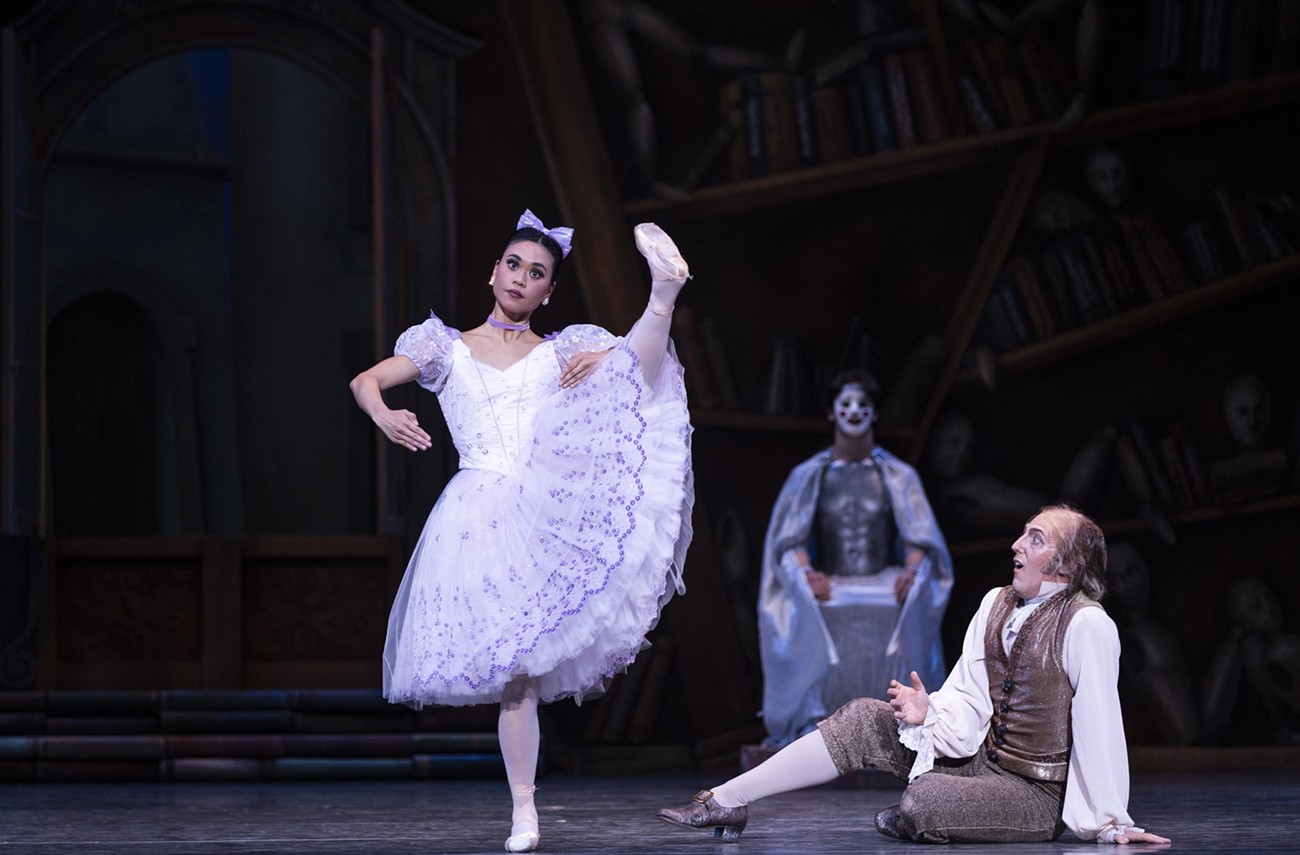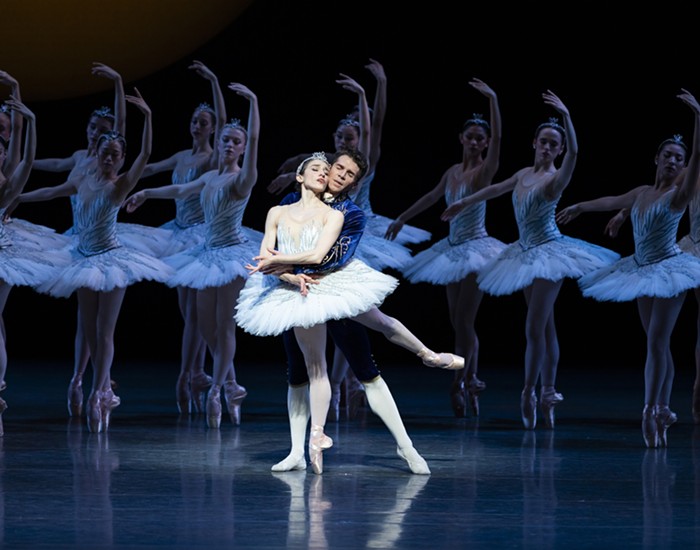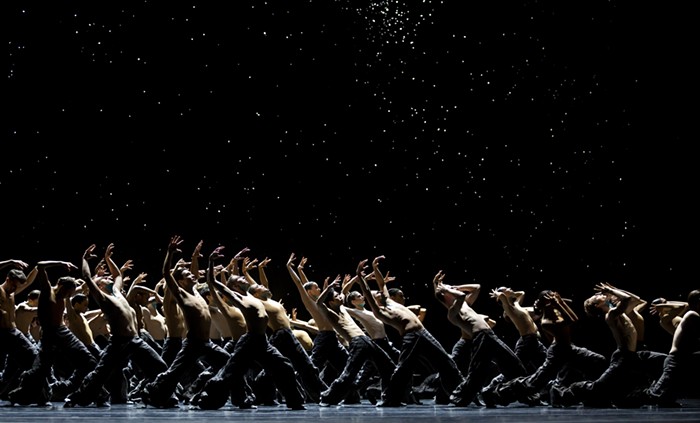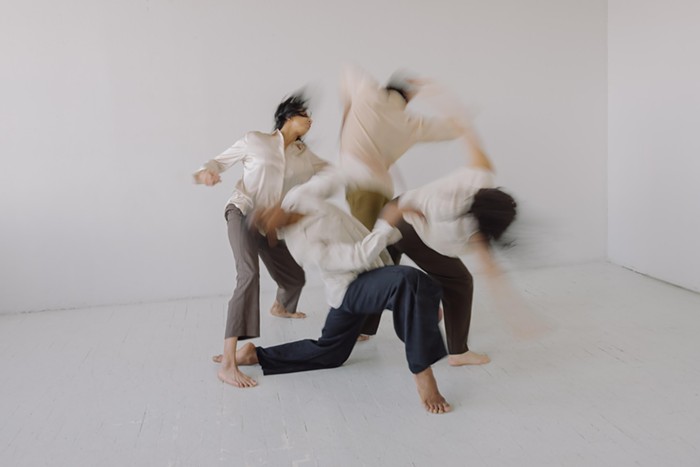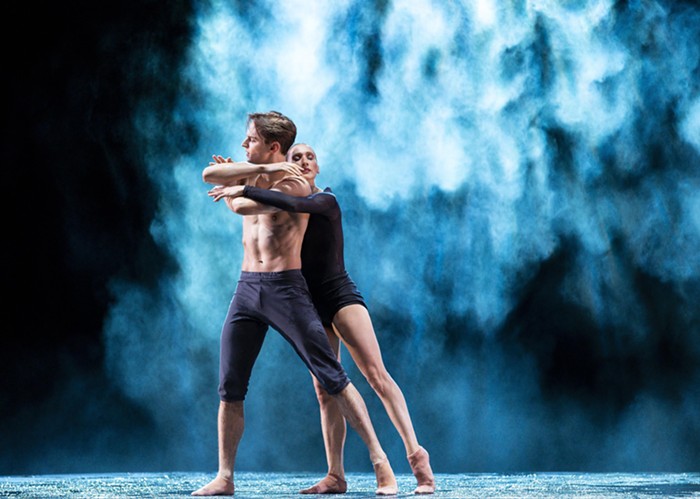Yeah, okay, sure, on one level, George Balanchine's Coppélia, which runs at McCaw Hall through June 9, is ultimately one of those goofy 19th-century fairy tale ballets with gorgeous sets, coquette aesthetics, an insane plot, and long stretches of time when the whole town engages in an elaborate dance-off. With the exception of a few ad-libbed contemporary gestures, Pacific Northwest Ballet's production holds true to Balanchine's revision of the old story.
However, in the age of artificial intelligence, deepfakes, and me not having tons of stuff to say about story ballets, I couldn't help but see the show as one, big allegory for humanity's triumph over the allures of AI, one that I hope proves true, though, knowing us, I have my doubts.
The three-act ballet, which is set to composer Léo Delibes's composition and based on the book by Charles Nuitter and Arthur St. Léon, which itself takes from E.T.A. Hoffmann's 1817 short story, Der Sandmann, centers on a pair of young lovers in some village nestled in the verdant corridors of Galicia, Spain.

The action kicks off when our hapless male protagonist, Franz, who was played on Saturday night by principal dancer Jonathan Batista, falls for a beautiful young woman reading a book on a balcony. Two problems: 1) Franz's girlfriend, Swanilda, played by principal dancer Angelica Generosa, doesn't take kindly to her boyfriend swooning for another beautiful young woman. 2) That beautiful young woman is actually not a beautiful young woman but rather a doll created by Dr. Coppelius, played by soloist Ezra Thomson, but nobody can tell she's a doll because she's so life-like, just like that bearded Mark Zuckerberg deepfake.
Wanting to teach her boyfriend a lesson, Swanilda sneaks into Coppelius's creepy-ass doll factory, dresses up in Coppélia's clothes, and lies in wait to pounce on Franz for being a bad boy. In pursuit of his infatuation, Franz breaks into the doll factory to look for Coppélia. In pursuit of his nefarious scheme to transfer the life-essence of a human being into his doll, Dr. Coppelius catches Franz in the factory, drugs him, and starts the life-essence transfer process.
At first, Swanilda plays along in the role of Coppélia, making the doctor think his evil plan worked, but eventually she spins him up, saves her boyfriend from certain doom, and escapes into the town square. In the last act, wedding bells hang overhead, Franz and Swanilda tie the knot, the villagers dance, and, somewhat inexplicably, a Trojan army skips around in glittering armor with spears held high.
And there you have it: An somewhat feminist fairy tale where a young woman, driven by her strong sense of interpersonal justice, uses a sort of reverse Turing test to save the world from an evil techno genius whose literary girlfriend doll prototype threatened the existence of productive human relationships, ultimately upholding a status quo secured in perpetuity by the bonds of marriage and protected, somewhat inexplicably, by a Trojan army skipping around in glittering armor.
As we continue taking steps into a future where techno freaks create deepfake Scarlett Johansson robot wives to destroy journalism and emotionally pacify corporate cogs, Coppélia firmly takes the side of real Scarlett Johansson, reminding us all of the singularity of the human experience and of how much we stand to lose to runaway technology.

The lush, hyper-realism of Roberta Guidi di Bagno's sets plays with these ideas. In the opening act, a glorious canopy of wisteria hangs over the set, looking almost AI-fake in its abundance. And yet, the flowers and foliage look so real you can almost smell them, inspiring a desire for a real walk through Japan's wisteria gardens. In the second act, the haunted, vertiginous doll factory's asymmetrical shelves underscore the corruption at the heart Dr. of Coppelius's vision. And in act three, the humongous wedding bells communicate the triumph of matrimony and music over the mismanaged affections of men.
And, then, of course, there's all the blood, sweat, and smiles of the dancing. As ever, Generosa and Batista charmed and wowed the audience with their acting and technical prowess, far surpassing those of any hologram or doll—for now, at least. Generosa's Swanilda/Coppélia was delightfully bratty and bubbly, and she made the show's moderately challenging footwork look easy. Batista embraced his role as an aloof hunk, brushing the dirt off his shoulders before moving into woo Coppélia and turning like a tornado with a big, beaming smile on his face. In the final duets, a couple holds looked shaky, but he executed the tricky-looking lifts effortlessly.
The parade of dances in the final act also helped drive home the power of performance, with soloist Amanda Morgan turning en pointe impossibly slowly in the "Prayer" sequences and nailing an arabesque or two, and soloist Kuu Sakuragi as a warrior jumping and spinning with explosive energy in the "Discord and War" section. Finally, major shoutout to Lucas Galvan, who as a defunct Acrobat Doll hit a series of extremely high split leaps that floored me.
If you're in the mood to lose yourself in fairy tale fantasy and to maybe idly think about the way that ballet in particular and the performing arts in general can save us all from the ravages of unchecked tech, then get yourself down to McCaw Hall this week. Pay-what-you-can Thursdays is a screaming deal, and the sets alone are worth the price of admission.
